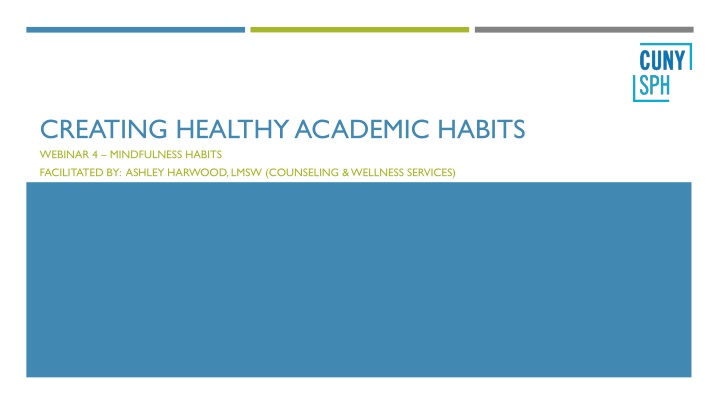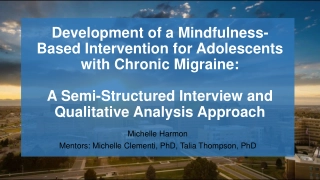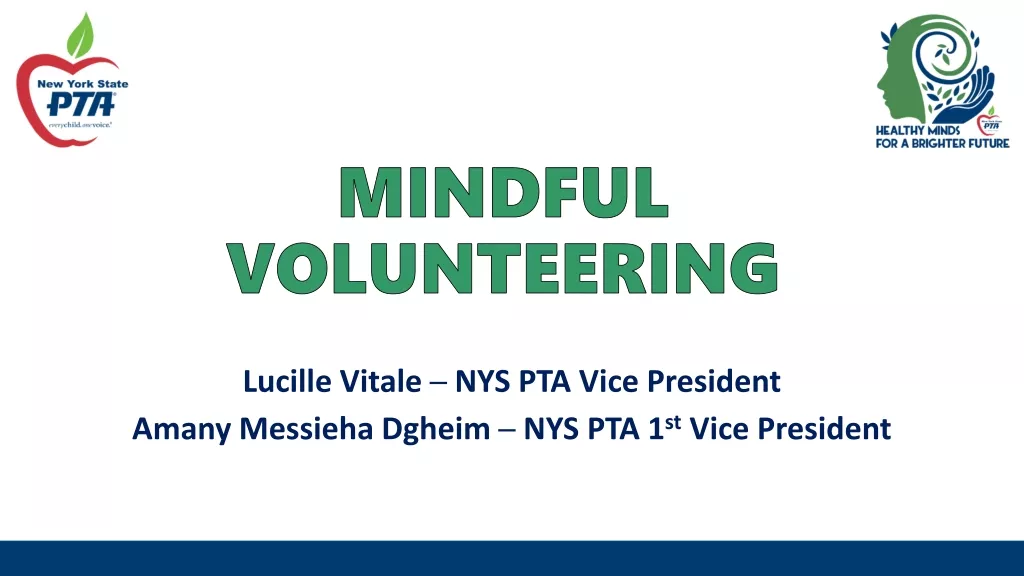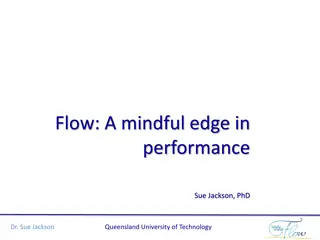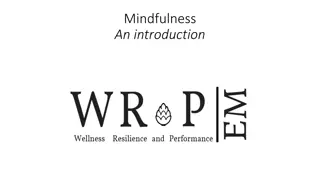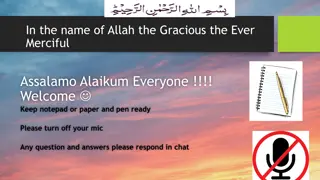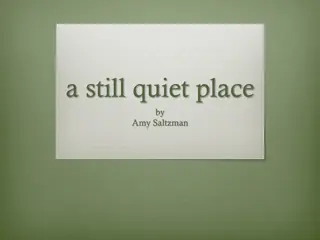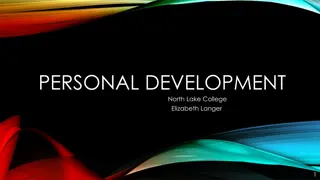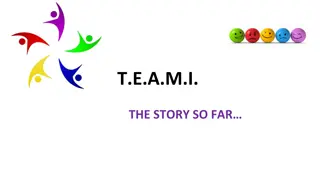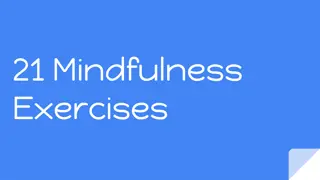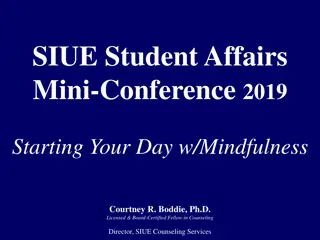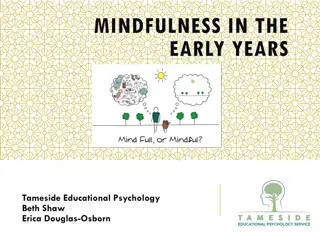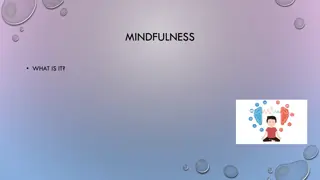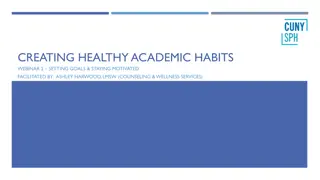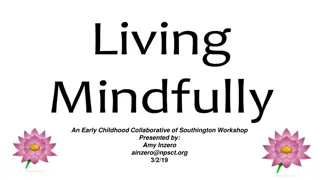Healthy Academic Habits Webinar on Mindfulness with Ashley Harwood, LMSW
Join the webinar series on creating healthy academic habits, focusing on mindfulness facilitated by Ashley Harwood, LMSW. Understand the concept of mindfulness, its practice, and benefits for students. Explore how mindfulness can improve focus, reduce stress, and enhance self-awareness in academic settings. Learn practical techniques to incorporate mindfulness into daily life for better well-being and academic performance.
Download Presentation

Please find below an Image/Link to download the presentation.
The content on the website is provided AS IS for your information and personal use only. It may not be sold, licensed, or shared on other websites without obtaining consent from the author.If you encounter any issues during the download, it is possible that the publisher has removed the file from their server.
You are allowed to download the files provided on this website for personal or commercial use, subject to the condition that they are used lawfully. All files are the property of their respective owners.
The content on the website is provided AS IS for your information and personal use only. It may not be sold, licensed, or shared on other websites without obtaining consent from the author.
E N D
Presentation Transcript
CREATING HEALTHY ACADEMIC HABITS WEBINAR 4 MINDFULNESS HABITS FACILITATED BY: ASHLEY HARWOOD, LMSW (COUNSELING & WELLNESS SERVICES)
HABITS THAT WELL COVER IN THIS WEBINAR SERIES: Time Management Goal Setting Self Care Mindfulness (This week!) Stress Reduction Combating Perfectionism Building Positive Self Talk
WHAT IS MINDFULNESS? PART 1 Mindfulness is a way of befriending ourselves and our experience. Jon Kabat-Zinn Mindfulness is both a practice and a way of relating to life. Researchers define it as the awareness that arises when we intentionally pay attention in a kind, open, and discerning way. When we are mindful, we focus on the present moment non-judgmentally. Example: A student practicing mindfulness in the middle of a school day might, pause, take a conscious breath, check in with himself, and observe how he is feeling before he takes a test. My heart is racing, and I feel anxious and maybe I also feel ready to go? It s okay to feel nervous right now; I can meet this challenge but what if I don t do well? I bet some of my friends are much more prepared. [Pause]. There goes my busy mind again. These questions pop up at times like these. I m just going to re-focus on my breath, and the paper in front of me right now. One step at a time. I can do this. *Adapted from https://thescholarshipsystem.com/blog-for-students-families/self-care-tips-for-college-students/
WHAT IS MINDFULNESS? PART 2 Mindfulness, as a practice, features two different types of attention:focused attention and open awareness. When we focus our attention, we concentrate on a specific target. Example: When leading students in a specific mindfulness practice, choose a place for them to anchor their attention like the sound of a chime, or the feel of the air entering their nostrils as they breathe. They can also quietly focus their attention on the shape, texture, and color of an object like a small stone. *Adapted from https://ggie.berkeley.edu/student-well-being/mindfulness-for-students/
WHAT IS MINDFULNESS? PART 3 During open awareness (also called open monitoring ), we simply notice things like thoughts, feelings, or sounds as they come and go. Example: To help students become more observant and aware of their surroundings, invite them to note all of the sounds they can hear inside and outside the classroom (after silently listening for one minute). Or ask them to practice noticing and naming their own feelings during a quick check-in at the start of class. *Adapted from https://ggie.berkeley.edu/student-well-being/mindfulness-for-students/
WHAT IS MINDFULNESS? PART 4 The practice of mindfulness also helps us to become more mindful in our daily lives by cultivating these three key life skills. Equanimity is the ability to allow sensory experiences to come and go without suppressing or avoiding them. Equanimity also helps us not to over-identify with an event, thought, or feeling (or make it too personal). Example: A student who is criticized by another student in the middle of class might learn say to herself, I m really hurt and embarrassed right now; I m feeling this intensely. I m not going to fight it, but I m not going to be swept up in it either. I m going to go to the peace corner (or another quiet space) and give myself a minute to let this pass. *Adapted from https://ggie.berkeley.edu/student-well-being/mindfulness-for-students/
WHAT IS MINDFULNESS? PART 5 Concentration is the ability to focus on what we consider to be relevant at a given time. Example: If students regularly practice mindfulness, they may start to find themselves more capable of focusing on a math problem in a given moment rather than being distracted by other classroom conversations, the sounds of kids playing outside, and/or the multitude of other things competing for their attention. (One thing at a time!) *Adapted from https://ggie.berkeley.edu/student-well-being/mindfulness-for-students/
WHAT IS MINDFULNESS? PART 6 Sensory clarity is the ability to keep track of what we re actually experiencing in the moment. Example: Students can learn to become more aware of the bodily sensations they feel when they experience challenging emotions like anger or fear like the pace of their heartbeat as it intensifies and then dissipates and eventually returns to normal. When they experience these sensations as signals of distress that begin and end, they may be more likely to ride the waves of their emotions, rather than being swept up in them. *Adapted from https://ggie.berkeley.edu/student-well-being/mindfulness-for-students/
5 REASONS MINDFULNESS IS SO POPULAR! Mindful.org says mindfulness is the fastest-growing health trend in the United States for many reasons, including these five: It helps with stress. Scientific research reported in Oxford Academic shows a positive correlation between mindfulness training and a reduction in the stress response of the brain s amygdala, which is the brain s fear-and-response control center. It helps with mental focus by clearing stress triggers and helps us learn to focus on the present. It boosts compassion toward others as well as to ourselves. It reduces negative thoughts and helps us redirect them to the present. It improves overall mental health. An Emory University study followed adults over 8 weeks of mindfulness attention training. The small group of adults had MRI brain scans before and after their training, which showed that amygdala activity decreased in response to images of stressful situations. Another study from the Journal of American College Health followed more than 400 women over two years in college and found that mindfulness practice resulted in healthier eating, better sleep, and better physical health. *Adapted from https://www.purdueglobal.edu/blog/student-life/college-students-guide-mindfulness/
HABIT 1: FOLLOW MINDFULNESS EXERCISES Follow a leader through a mindfulness exercise to calm your mind down in the moment through a guided practice. There are pre-recorded mindfulness exercises available on podcast platforms, YouTube, and many other outlets. You can also join a live mindfulness exercise on several streaming platforms. *Adapted from https://www.suu.edu/blog/2021/10/mindfulness-techniques-students.html
HABIT 2: PRACTICE S.T.O.P. STOP is a four step mindfulness technique that can be done virtually anytime and anywhere when you are feeling overwhelmed. Here are the steps: S: Stop Stop what you are doing. Stop what you are thinking. Take a moment to dedicate yourself to mindfulness. T: Take a breath Take a deep breath in and out. Find a method that works for you and slows you down. You might count up or down, close your eyes, breathe in through your nose and out through your mouth, etc. O: Observe Take a moment to observe how you feel physically and mentally. Try to identify your feelings. Alternatively, take a moment to observe your surroundings. Focus on the details and how they make you feel. P: Proceed Proceed intentionally with the task at hand. If you need to slow down, slow down. If you need to set a time limit, set a timer. If you need to drink some water, grab some water. Practice being in tune with yourself and proceed with your day in a way that makes sense for you. *Adapted from https://www.suu.edu/blog/2021/10/mindfulness-techniques-students.html
HABIT 3: SENSORY EXERCISES Sensory exercises are a great way to practice mindfulness by reaching out to immediate, tangible experiences. This is a way to ground yourself in the present moment and space. Try out these sensory exercises: Place your hands in water Hold a piece of ice in your hand Touch or hold something comforting (i.e., a soft blanket, a stuffed animal, etc.) Savor a scent you enjoy (i.e., light a candle, brew a cup of tea, etc.) Listen to your surroundings Practice mindful eating (slow down, take smaller bites, savor the flavors) *Adapted from https://www.suu.edu/blog/2021/10/mindfulness-techniques-students.html
HABIT 4: BREATHING EXERCISES Simply taking a moment to notice your breathing can be helpful in overwhelming situations. Intentionally practicing breathing slows your heart rate and can decrease your blood pressure. Breathing can also send a relaxation signal to your brain, helping your entire body reach a state of calm. Next time you need to take a moment of pause, try one of these breathing exercises: Deep Breathing: Simply inhale slowly through your nose, then exhale slowly out through your mouth. If it helps, you can inhale and exhale for the same amount of time; maybe four seconds. Resonance Breathing: Laying on your back, inhale slowly for six seconds, then exhale slowly for six seconds. Repeat this for about 10 minutes or as needed. Alternate-Nostril Breathing: Push one of your nostrils closed and breathe in. At the top of your breath, open your closed nostril and close the other nostril before exhaling. Repeat this exercise. Affirming Phrase:As you inhale, say something that you would like to manifest. For example, I breathe in peace. As you exhale, say something that you would like to get rid of. For example, I breathe out stress. Repeat this exercise a few times. *Adapted from https://www.suu.edu/blog/2021/10/mindfulness-techniques-students.html
HABIT 5: PHYSICAL EXERCISES Physical exercises are another mindfulness activity to utilize when you are feeling stressed or overwhelmed. Physical exercise doesn t need to be vigorous exercise; sometimes, the most useful physical exercise is simply getting up out of your chair and moving around for a little bit. Next time you need to get up and move, try one of these exercises: Go for a walk Take out your trash or get the mail Do a body scan from your head to your toes, focusing on how your entire body is feeling Ask these questions to take an inventory: Are you holding tension in your jaw? How does your neck feel? Notice how your arms hang from your shoulders. How is your posture? Where are your feet? Practice a few yoga poses Dance to your favorite song *Adapted from https://www.suu.edu/blog/2021/10/mindfulness-techniques-students.html
HABIT 6: PRACTICE 5-4-3-2-1 SENSES EXERCISE 5-4-3-2-1 is a great mindfulness exercise that can be done anywhere and it doesn t take long to do. Tapping into the 5 senses, this exercise encourages you to focus on your surroundings and your body. Here are the steps for 5-4-3-2-1: What are 5 things you hear? What are 4 things you see? What are 3 things you can touch? What are 2 things you can smell? What is 1 thing you can taste? *Adapted from https://www.suu.edu/blog/2021/10/mindfulness-techniques-students.html
HABIT 7: NOTICE NATURE At least once a day, go outside for 15 to 20 minutes to notice nature. Use your senses to take in the sights, scents, and sounds of nature. This is also a good place and time to practice your mindful breathing. As thoughts of work, family, life, and to-do lists creep into your thoughts, set them on a mental shelf and return your thoughts to the plants, animals, and natural creations around you. *Adapted from https://www.purdueglobal.edu/blog/student-life/college-students-guide-mindfulness/
HABIT 8: USE AN ANCHORING PHRASE If you need something quick and calming to stay grounded, try repeating an anchoring phrase. Your anchoring phrase can be the same every time (a motivating quote or word) or it can be about something in the moment. Repeat whatever is comforting to you. An anchoring phrase for the moment can follow a format similar to this: My name is Today is Right now I feel *Adapted from https://www.suu.edu/blog/2021/10/mindfulness-techniques-students.html
REVIEW OF KEY ELEMENTS: Your mindfulness practice doesn t have to be perfect. In fact, it doesn t need to fit any prescription for success.Here s a review of the four key components of mindfulness: Attention regulation:Allowing the mind to wander freely and gently nudging it away from negative, obsessive, and stress-inducing thoughts to the present moment. Body awareness: Mentally scanning yourself from head to toe, especially those stress centers where you hold tension (jaw, neck, shoulders, back). Change in perspective of self: Increasing the ability to see yourself as always changing can lead to enduring forms of happiness. Emotion regulation: Helping you adjust your emotional responses to unpleasant and pleasant situations. *Adapted from https://www.purdueglobal.edu/blog/student-life/college-students-guide-mindfulness/
REMINDER TO: UTILIZE CUNY SPH COUNSELING & WELLNESS SERVICES OR MENTAL HEALTH RESOURCES IN YOUR COMMUNITY NOTE: Mindfulness should not replace medications or other therapies prescribed by your health care or mental health care provider. If you are experiencing depression, anxiety, or other mental distress, see your provider right away. SPH Counseling & Wellness: Free counseling support for students living in NY state. We can offer referrals for students out of state. https://sph.cuny.edu/students/student-services/student-wellness/counseling-and-wellness-services/ Mental Health Resources: For free 24/7 support or referrals there is CUNY Crisis, NYC WELL or the national 988 mental health hotline (info below) Crisis Text Line: Text CUNY to 741741 for crisis counseling NYC WELL: Text WELL to 65173; Chat:https://nycwell.cityofnewyork.us/en/; Call 1-888-NYC-WELL (1-888-692-9355) 988: Text to 988; Chat:https://988lifeline.org/chat/; Call 988 For outside providers: Search providers through your health insurance website Psychology Today: https://www.psychologytoday.com/ Open Path Collective: https://openpathcollective.org/ Telehealth clinics: Mindful Care https://www.mindful.care and Lifestance Health https://lifestance.com/
REMINDER TO: PRACTICE POSITIVE AFFIRMATIONS I have the power to make a difference I am an amazing person Everything I need is within me I learn from my mistakes I am strong and capable It is ok to make mistakes I have the power to choose how my day will be
